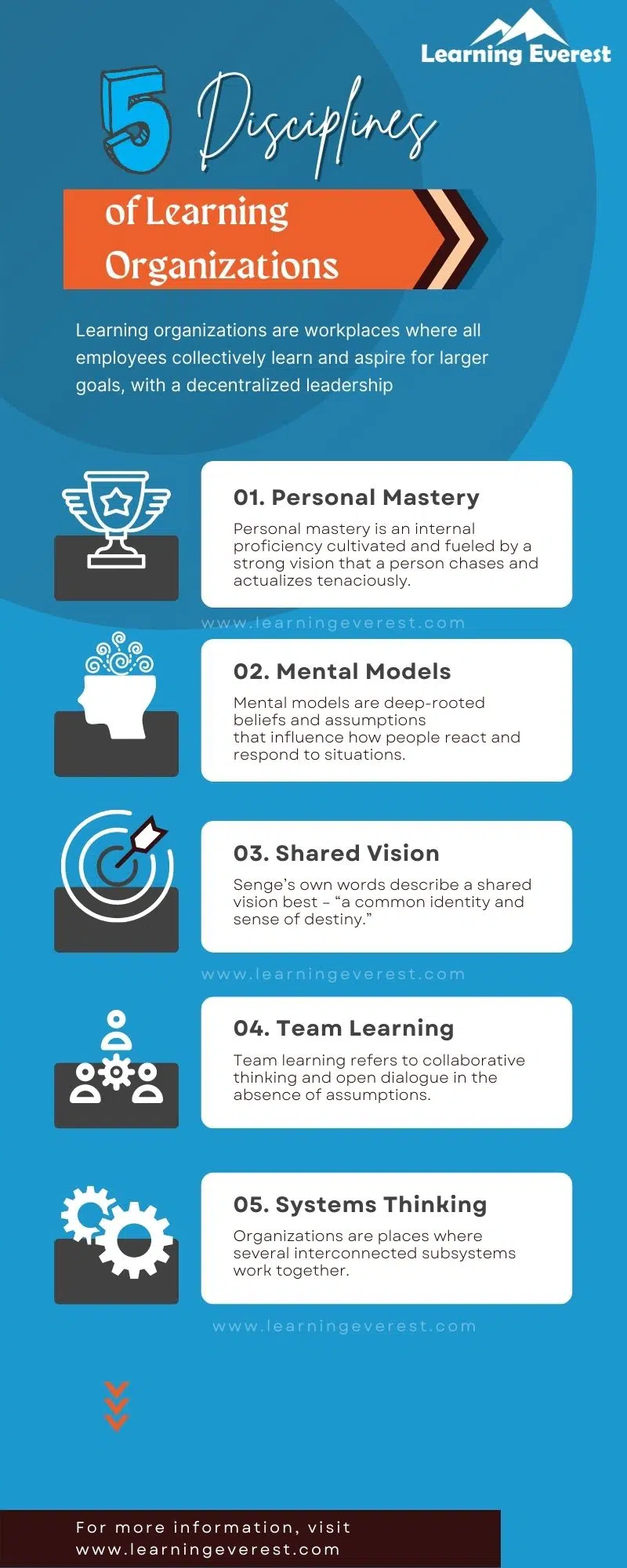Are you familiar with “learning organizations”? Apex companies have one thing in common: a strong learning culture. Successful leaders understand the importance of broadening their horizons and consequently attract and shape similar employees.
Table of Contents
- Learning Organizations: Explained
- The 5 Disciplines of a Learning Organization
- Conclusion
- Infographics
- Knowledge Check!
- Frequently Asked Questions (FAQs)
- What is an example of a learning organization?
- What are five elements of a learning organization?
- What are learning organizations?
- Why are learning organizations important?
- References
Discover the five essential disciplines that define successful learning organizations and foster a thriving culture of growth.
The salience of continued learning and development has caught up considerably in the corporate world. Most businesses today pursue sustained learning and development of some kind. However, there is more to becoming a learning organization than that. Peter Senge, the proponent of learning organizations, holds that becoming one requires the consistent pursuit of one or more of 5 “disciplines.”
Keep reading for a deeper look.
Learning Organizations: Explained
Senge popularized learning organizations through his 1990 book “The Fifth Discipline: The Art & Practice of the Learning Organization.” He adopted a systems thinking approach to organizational development and concluded that when all employees collectively learn and aspire for larger goals, with a decentralized leadership, a learning organization is formed.
In his own words, he described such workplaces as:
Organizations where people continually expand their capacity to create the results they truly desire, where new and expansive patterns of thinking are nurtured, where collective aspiration is set free, and where people are continually learning how to learn together.
He further expanded upon the idea as effective teamwork on a large scale, where a “group of people function together in an extraordinary way.”
To successfully become a learning organization, a company must pursue five separate but interconnected disciplines, namely:
- Personal mastery
- Mental models
- Building shared vision
- Team learning
- Systems thinking
The following section will explore these disciplines in greater detail, along with examples from highly successful businesses to draw inspiration from.
The 5 Disciplines of a Learning Organization
Any of the five disciplines opens up a path to becoming a learning organization. However, once implemented, they invariably tend to create conditions for the other principles to flourish.
1. Personal Mastery
Personal mastery is the most individual-centered out of the five disciplines. It is an internal proficiency cultivated and fueled by a strong vision that a person chases and actualizes tenaciously.
In Senge’s opinion, employees who are personally dedicated to learning shape organizations of the same kind. For instance, in a 2021 study, Fateh et al. found that personal mastery is a significant predictor of creative behavior in software engineers. In another study, Garcia-Morales et al. (2007) discovered that personal mastery influences organizational performance by enhancing organizational learning and innovation. These are just two examples out of a massive body of literature supporting personal mastery.
Given the benefits, how can someone up their personal mastery game? Developing the following seven characteristics is a good place to start:
- A strong sense of purpose or vision
- Being accepting of reality, whether good or bad and growing from it
- Learning to work with change instead of resisting it
- Being curious and refining one’s perception of reality continuously
- Feeling connected with life and others
- Accepting your uniqueness and finding your true self
- A sense of feeling connected to a larger creative process and contributing to it
Personal Mastery Example
Adobe’s Kickbox program is an excellent example of a learning organization promoting personal mastery.
Any employee with an idea can avail this program. Upon applying, they receive a red cardboard box with stationary and a pre-paid credit card worth $1000 inside it. Employees are free to use these funds however they like to turn their idea into a reality. There are no penalties if the invention or product does not work out. However, if it does gain momentum, Adobe invests further for the idea to become as successful as possible.
Through this program, Adobe gives its employees the means to use their professional work as an outlet to pursue their personal vision, i.e., a direct shot at increasing their personal mastery.
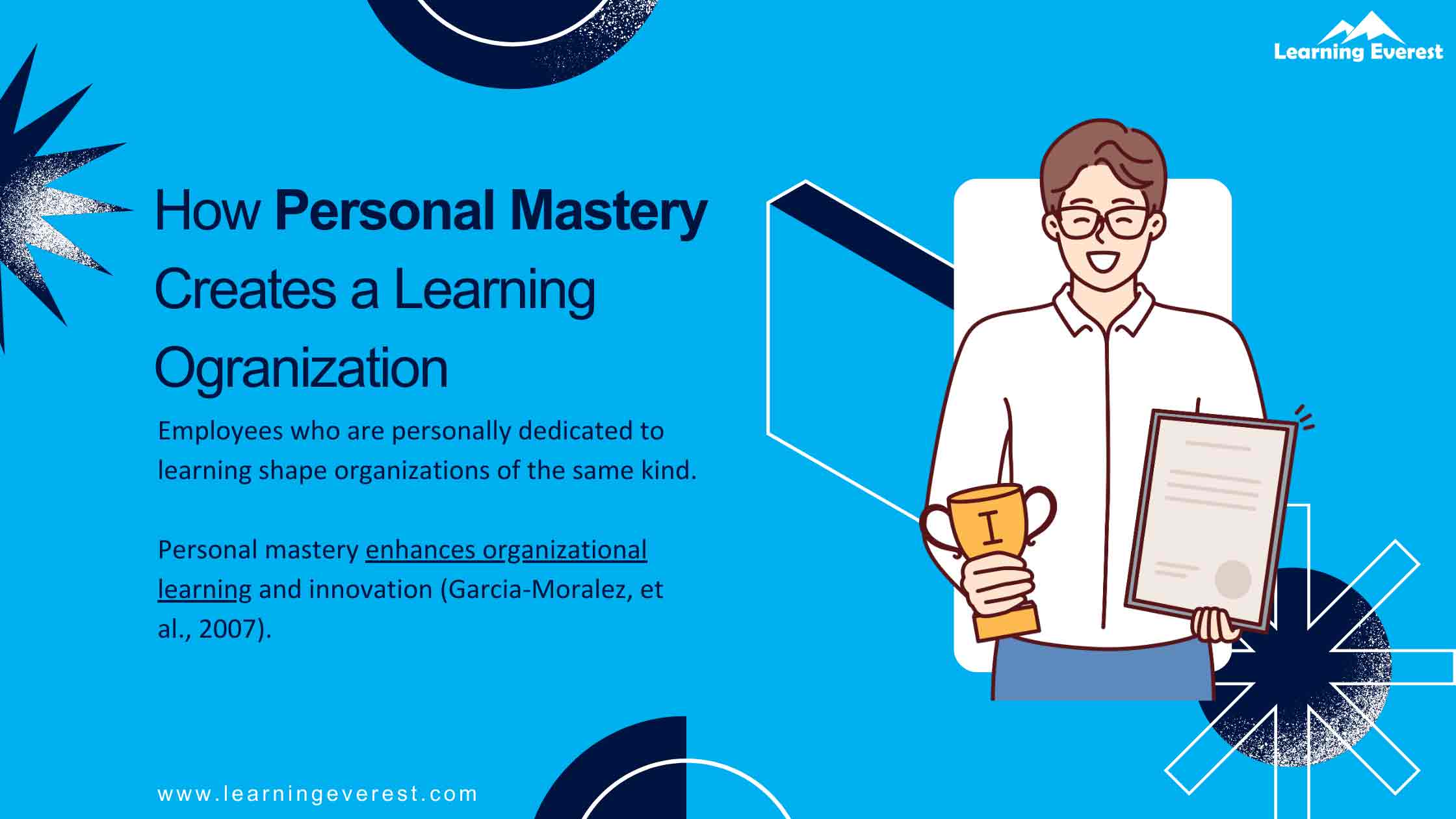
Disciplines of a Learning Organization – Personal Mastery
2. Mental Models
Mental models are deep-rooted pre-existing beliefs and assumptions people have about the world, themselves, and other people. These beliefs influence how they react and respond to situations. Often, individuals are not aware of their mental models and their effects since they are so ingrained that they occur subconsciously.
For an organization to transition to a learning organization, leadership and employees need to become self-aware of their mental models.
Once everyone understands how their internal thinking patterns affect their actions, they can start deconstructing them. Changing mental models requires self-reflection and open conversations among co-workers and managers to form new belief systems.
Evolved and conscious mental models improve the company’s overall potential for development, action, and creativity.
Mental Models Example
AlphaSights, a leading knowledge services firm, practices what it preaches. It has a forward-thinking approach to employee training and development and a full-fledged blended digital learning program.
The firm invests heavily in its employees’ development and tailors courses to tackle existing job obstacles. In 2019, AlphaSights even entered a partnership with 360Learning to improve the quality of its training programs.
The company, thus, demonstrates an ability to analyze and change existing systems for increased efficiency and output.
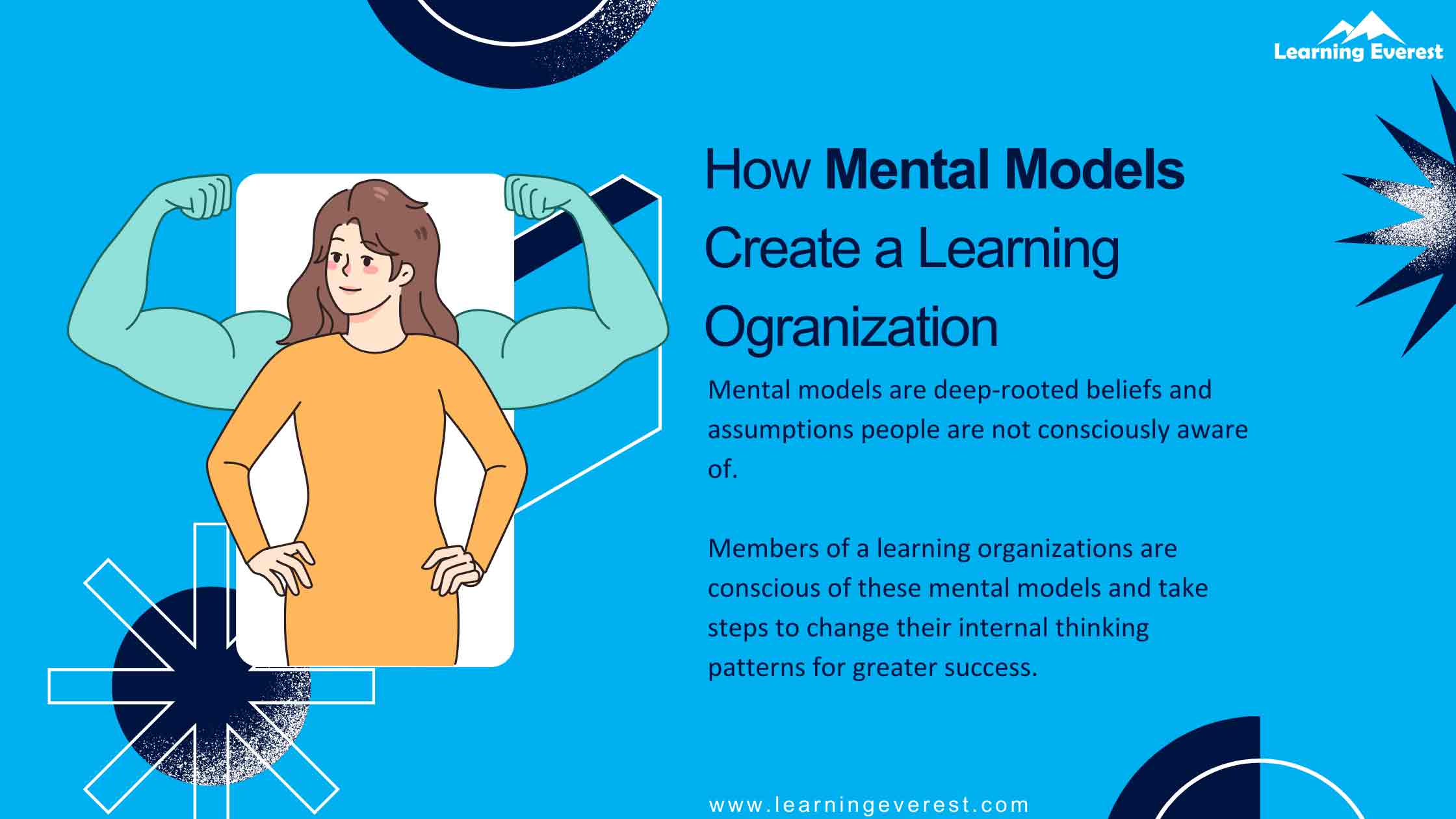
Disciplines of a Learning Organization – Mental Models
3. Building Shared Vision
Senge’s own words describe a shared vision best – “a common identity and sense of destiny.”
A well-executed and authentic vision binds an organization’s members to take collaborative and meaningful action for the greater good. Thus, visions should be established as a team effort, considering everybody’s input.
Doing so helps employees feel connected to their work as it becomes an outlet or extension of their ambitions and goals. Non-learning organizations fail to fulfill this crucial requirement, creating a disconnect and lack of inspiration in their employees.
Shared Vision Example
Publix is a unique supermarket chain where all employees own a share. In other words, employees are active stakeholders in the business. Additionally, the company offers ample upward mobility options to workers by promoting from within. As a result, Publix has long employee tenure. In fact, the current CEO started out as a bagger in the 1980s.
Publix maintains a shared vision of quality, service, and continued excellence by making employees shareholders and making internal mobility a guaranteed outcome of good performance.
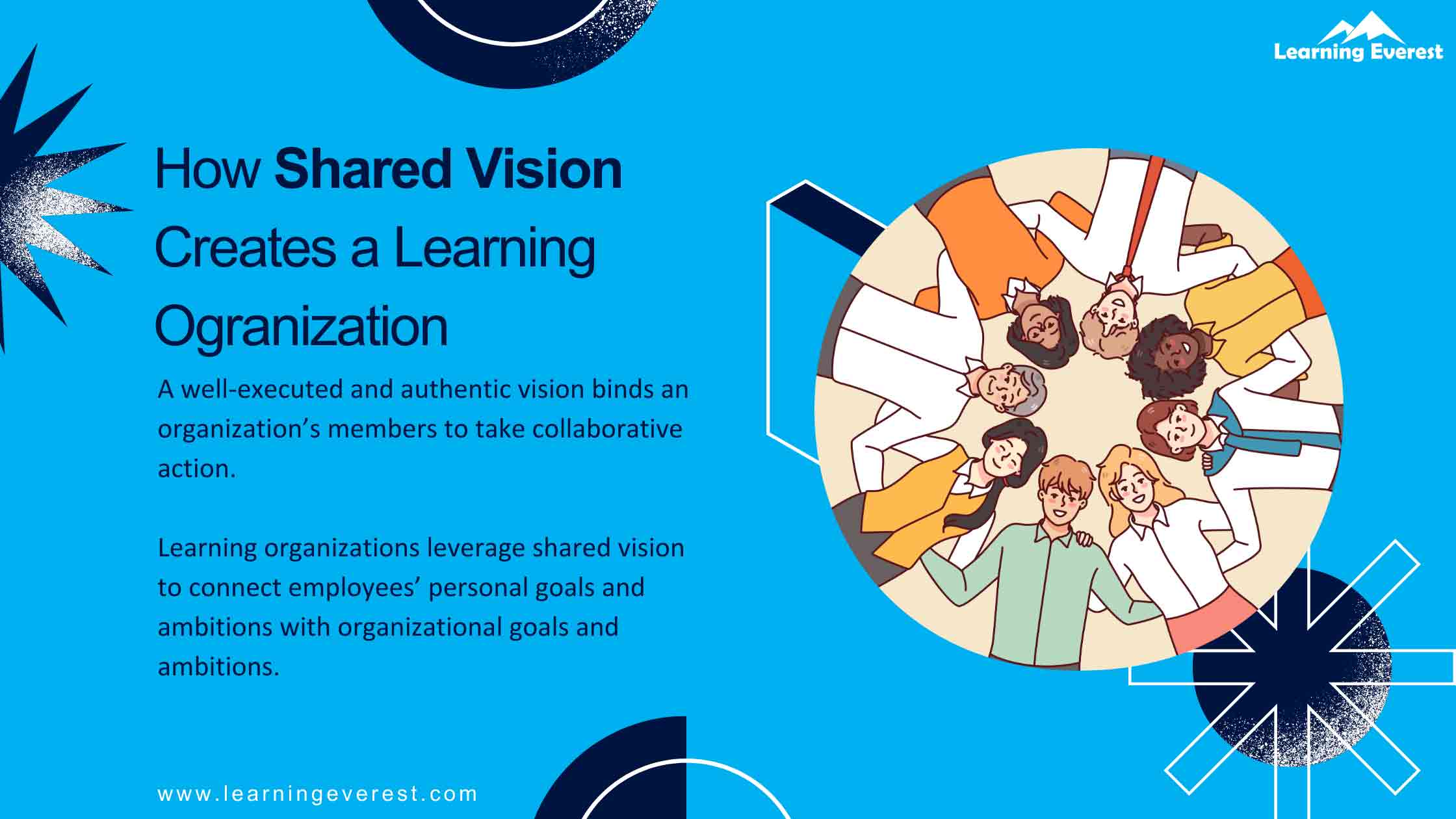
Disciplines of a Learning Organization – Building Shared Vision
4. Team Learning
Team learning refers to collaborative thinking in the absence of assumptions. According to Senge, team learning occurs when there is an open and productive dialogue between members. He distinguishes dialogues and discussions. While discussions aim to prove one point over the other, dialogues flow freely.
When members participate in open dialogues, they set aside their assumptions, prejudices, and static thinking. Everyone gets a chance to contribute, and all ideas are accepted with an open mind. By doing so, people get to expand their existing knowledge and challenge their thoughts, thus contributing to a learning organization.
Listen more than you talk. Nobody learned anything by hearing themselves speak.

Tip from Sir Richard Branson about Learning Organization
Team Learning Example
General Electric is known for being a boundaryless organization. A strong culture of team learning achieved this. The norm for decision-making in GE is open communication across several different company levels. GE emphasizes collaboration in all its endeavors and rejects hierarchies. It also has a reverse mentoring culture, encouraging junior employees to impart knowledge to senior employees. Through these efforts, GE makes everybody feel involved and valued and breaks down arbitrary organizational boundaries for increased productivity.
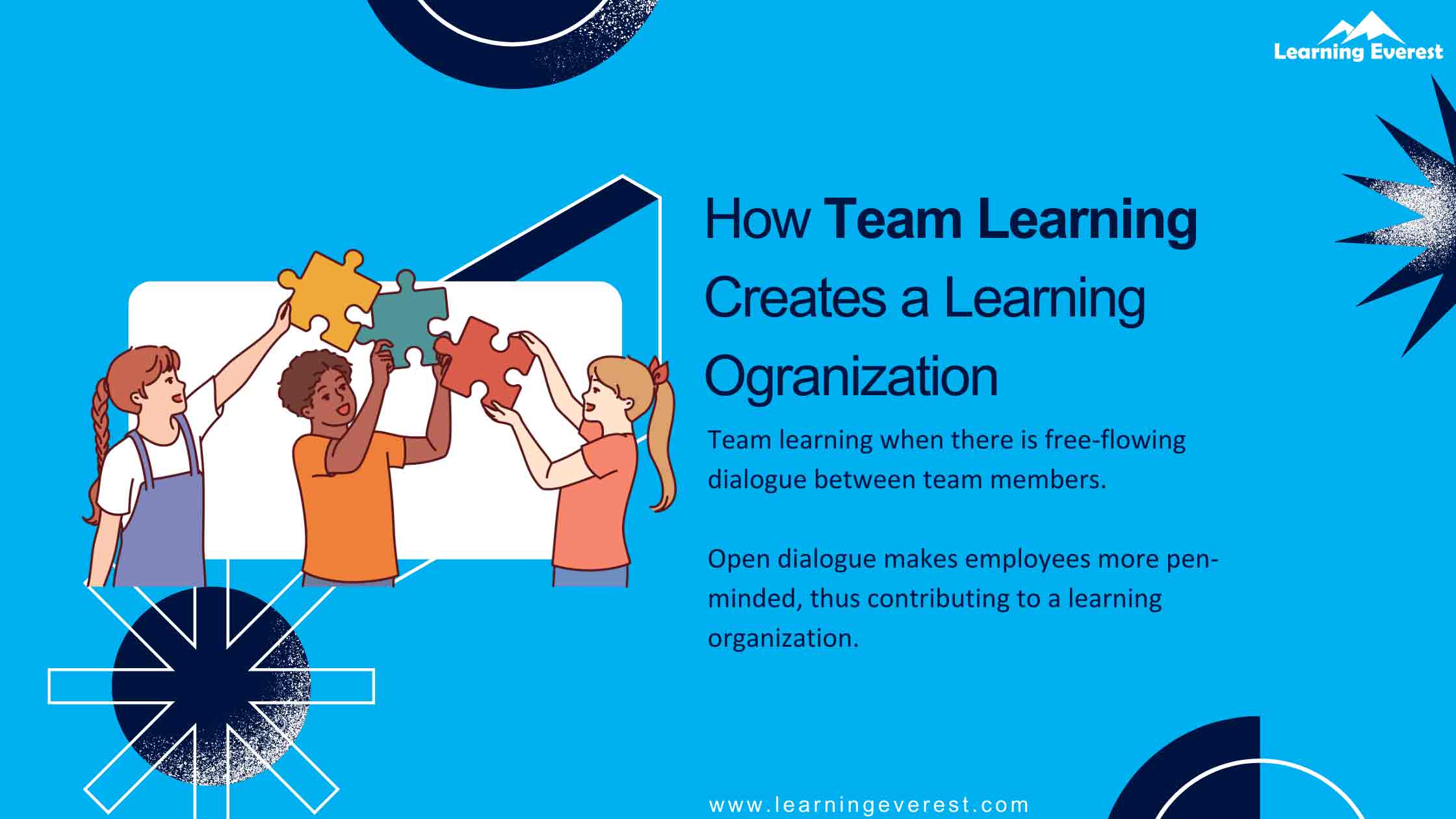
Disciplines of a Learning Organization – Team Learning
5. Systems Thinking
Systems thinking is the glue that holds all the other disciplines together. It is a school of thought in which the world is understood as distinct but interrelated parts. These parts, although separate, function together and are affected by each other. Thus, a broad view of how things interact is essential to understanding the world accurately.
Senge applied this principle to organizations as places where several interconnected subsystems work together. The optimal functioning of the various subsystems creates the environment for a learning organization to thrive.
Adopting a systems thinking approach to one’s organization allows employees and leadership to identify where they need to improve in terms of the other principles.
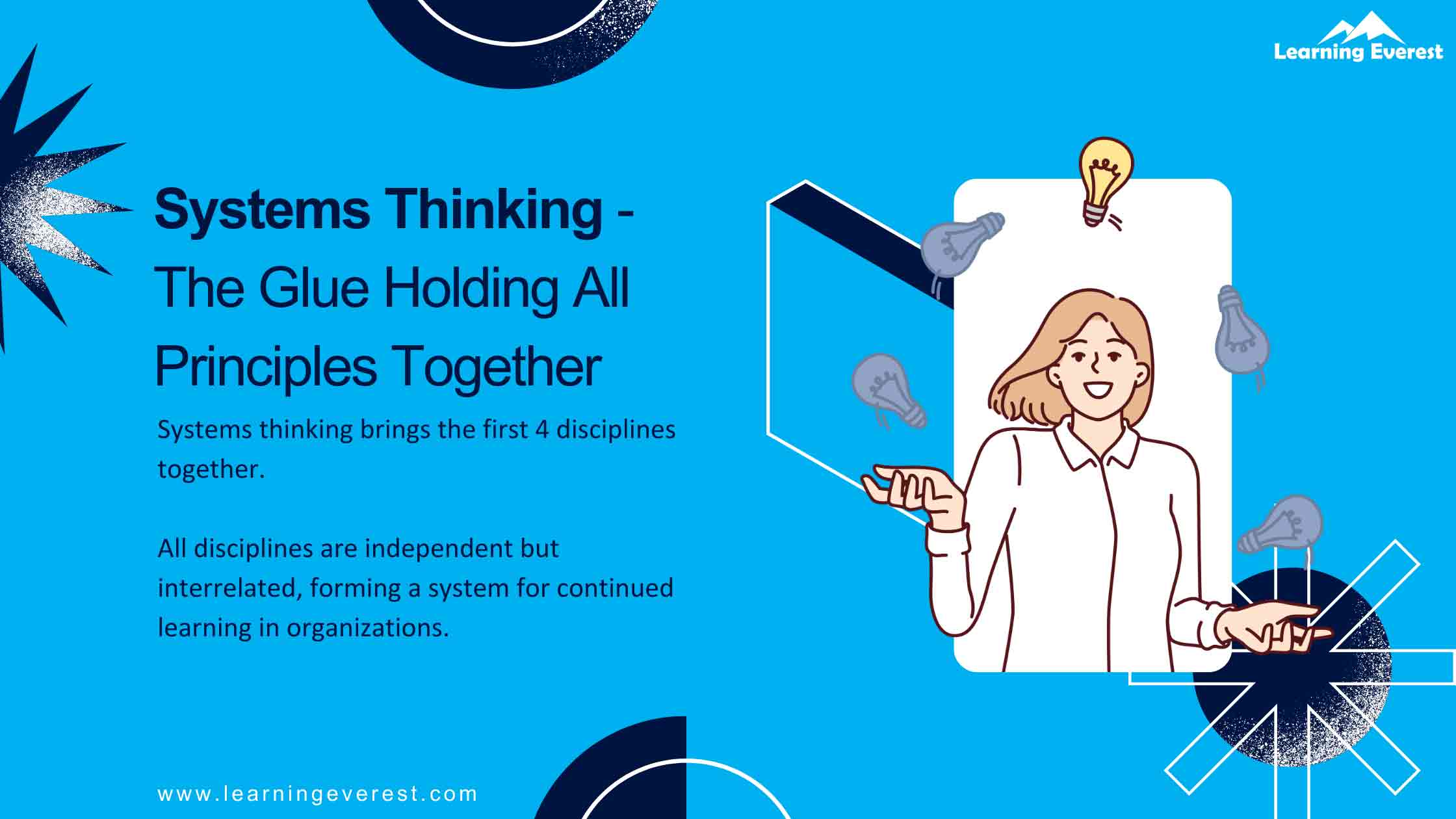
Disciplines of a Learning Organization – Systems Thinking
Conclusion
Learning organizations cannot be built overnight. It requires a coordinated and sustained effort from all departments and levels. However, once there is momentum, the path ahead is positive change and development.
Infographics
Knowledge Check!
Frequently Asked Questions (FAQs)
What is an example of a learning organization?
Some examples of learning organizations are Adobe, AlphaSights, Publix, and General Electric.
What are five elements of a learning organization?
The 5 elements of a learning organization are:
- Personal mastery
- Mental models
- Building shared vision
- Team learning
- Systems thinking
What are learning organizations?
Peter Senge described learning organizations as “organizations where people continually expand their capacity to create the results they truly desire, where new and expansive patterns of thinking are nurtured, where collective aspiration is set free, and where people are continually learning how to learn together.”
Why are learning organizations important?
Apex companies have one thing in common: a strong learning culture. Successful leaders understand the importance of broadening their horizons and consequently attract and shape similar employees.
References
- Senge, P. M. (2006). The fifth discipline: The art and practice of the learning organization. New York: Doubleday/Currency
- Víctor J. García-Morales, Francisco Javier Lloréns-Montes, Antonio J. Verdú-Jover. 2007.Influence of personal mastery on organizational performance through organizational learning and innovation in large firms and SMEs. Technovation, 27 (9). 547-568.
- Fateh, A., Mustamil, N. & Shahzad, F. Role of authentic leadership and personal mastery in predicting employee creative behavior: a self-determination perspective. Front. Bus. Res. China 15, 3 (2021). https://doi.org/10.1186/s11782-021-00100-1


